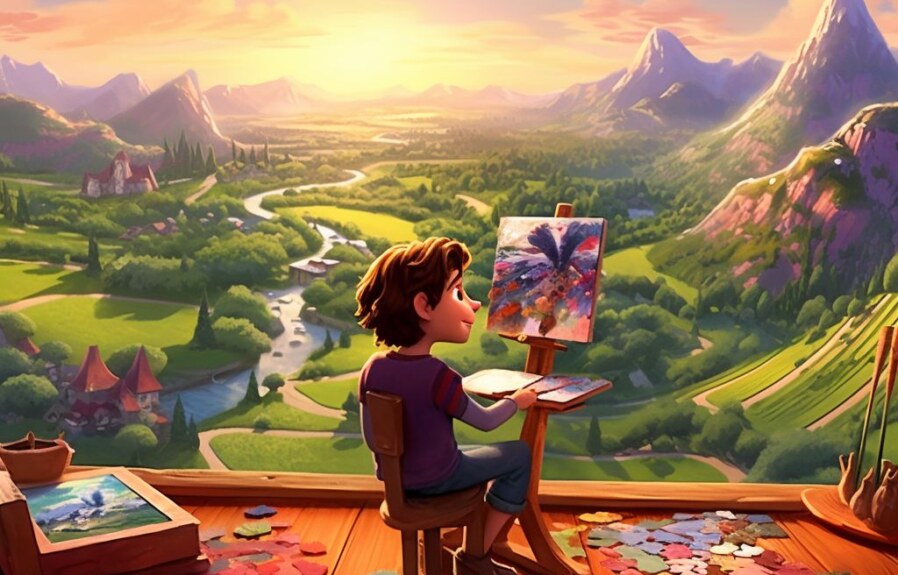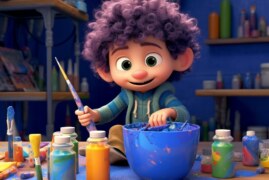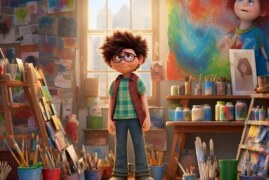For aspiring artists, mastering the art of drawing backgrounds is essential to bring their artwork to life. Backgrounds are the foundation for any drawing, and it’s necessary to pay close attention to the details and composition to create a compelling visual experience. Drawing backgrounds can seem like a daunting task, especially if you’re just starting. However, with the proper guidance and practice, anyone can learn to draw stunning backgrounds. In this article, we’ll guide you through the fundamental techniques and steps to draw backgrounds like a professional. So, get your pencils ready and let’s dive in!
1. Introduction: The Importance of Backgrounds in Artwork
Backgrounds are an essential component of artwork. They add depth, context, and meaning to an image. A well-designed background can enhance the overall composition and draw the viewer’s attention to the subject. In contrast, a poorly executed background can detract from the artwork’s impact.
Backgrounds can create a sense of atmosphere or mood. For instance, a dark, moody background can enhance the feeling of fear or suspense in a horror scene. Similarly, a bright, cheery background can evoke a sense of joy or playfulness in a cartoon. In this way, backgrounds contribute to the overall tone and emotional impact of the artwork.
Furthermore, backgrounds provide crucial information about the setting and context of the artwork. They can provide clues about the time period, location, and culture represented in the image. By using appropriate visual cues and symbols, artists can communicate a wealth of information without using words. In this way, backgrounds can enrich the viewer’s understanding and appreciation of the artwork.
2. Materials and Tools Required for Drawing Backgrounds
Materials required:
Tools Required:
Drawing backgrounds can be challenging and requires specific tools to ensure accuracy, proportion, and scale. A pencil is essential for sketching out the rough draft of the background, and an eraser will come in handy for correcting mistakes. Using a ruler or T-square to draw straight lines will add precision, while a compass can be used for circular shapes. A protractor may be needed to measure angles accurately.
Paint brushes of different sizes will be useful in adding color or texture to the background. A drawing board is optional but recommended, as it can provide better support while working, especially for large or detailed backgrounds. Remember to use high-quality materials for a finished product that is both visually stunning and durable.
To make the best use of these tools, carefully plan out the background before beginning. Decide on the composition, perspective, and color scheme before putting pencil to paper. Use your tools appropriately to create a background that is visually appealing and adds depth and realism to your artwork.
3. Basic Techniques for Creating Backgrounds: Perspective andComposition
Perspective and composition are two fundamental techniques that can be applied to create visually appealing backgrounds for various design projects. Here are some basic tips to help you master your skills:
– Perspective: This technique refers to the representation of three-dimensional objects on a two-dimensional surface. A background with good perspective can give the impression of depth, distance, and spatial relationships. To achieve this effect, try the following:
– Use lines and vanishing points to create the illusion of depth and distance.
– Place objects in the foreground, middle ground, and background to make them appear more lifelike.
– Adjust the size, shape, and position of objects according to their location in the scene.
– Composition: This technique involves arranging elements in a visually pleasing manner. A background with good composition can help draw attention to the focal point of your design. To achieve this effect, try the following:
– Use the rule of thirds to divide your background into a grid and position objects along the intersections.
– Create contrast by varying the size, color, and texture of objects in the foreground, middle ground, and background.
– Use negative space to balance the composition and make it less cluttered.
In conclusion, mastering the techniques of perspective and composition can help you create engaging backgrounds that enhance your design projects. Practice these tips and experiment with different combinations to find the ones that work best for you.
4. Working with Different Mediums: Tips and Tricks for Drawing Digital and Traditional Backgrounds
When it comes to drawing backgrounds, there are two main mediums to work with: digital and traditional. Both mediums have their pros and cons, but it’s important to know how to work with both in order to expand your skills as an artist. Here are some tips and tricks for each medium:
Digital Backgrounds
- Use layers to your advantage. This will make it easier to make changes and adjustments as you go along.
- Learn how to use different brush presets. This will allow you to create different effects and textures that can really enhance your background.
- Use reference images to help guide you. This will ensure that your background looks realistic and accurate.
Traditional Backgrounds
- Experiment with different materials such as watercolors, pastels, and charcoal. Each material has its own unique qualities that can add depth and texture to your background.
- Pay attention to your lighting. Shadows and highlights are crucial in creating a believable background.
- Practice your perspective drawing. This will give your background a sense of depth and space.
Remember, whether you’re working with digital or traditional mediums, the key to creating a great background is practice and patience. Use these tips and tricks to help guide you, but don’t be afraid to experiment and find your own style.
5. Adding Detail and Texture to Your Background: Techniques for Creating Realistic and Atmospheric Environments
One way to add detail and texture to your background is by using different layer styles and techniques. You can add various gradients and filters to your layers, such as noise or cloud effects, to create a realistic and atmospheric environment. Additionally, adding texture to your background using patterns or custom brushes can enhance the depth and dimension of your scene. Make sure to continually adjust the opacity and blending modes of your layers to create a seamless integration of the different elements.
Another technique to add realism and atmosphere to your background is by incorporating references of real-world environments. Referencing textures, colors, and lighting from nature or photographs can help bring your background to life. Pay attention to the lighting and shadows in your background and adjust them accordingly to create depth and dimension. Remember to use layers and masks to make precise decisions throughout the process.
Overall, creating a detailed and textured background involves experimentation and attention to detail. Don’t be afraid to adjust and modify your work as you go, and always refer back to your references for guidance. Incorporating these techniques into your workflow will ensure that your backgrounds are immersive and visually impactful.
6. Common Mistakes to Avoid When Drawing Backgrounds
When it comes to drawing backgrounds, there are some common mistakes that artists should avoid. Here are some of the biggest blunders to steer clear of, along with tips to help you create beautiful backgrounds.
- Not considering perspective: One of the biggest mistakes beginner artists make is not considering perspective. Without perspective, your backgrounds can look flat and lifeless. Always think about how objects would appear in three-dimensional space and use perspective lines to guide your drawing.
- Overcrowding: Another issue is overcrowding your background. It can be tempting to add too much detail, but too many objects can make the scene appear cluttered and chaotic. Instead, focus on the key elements and use negative space to help guide the viewer’s eye.
- Lack of attention to lighting and shadows: Light and shadows can make or break a background. Without proper attention to lighting and shadows, your scene can look flat and unrealistic. Be sure to consider where your light source is coming from and how it would affect the objects in your background.
By avoiding these common mistakes, you can create background art that enhances your overall piece rather than detracting from it. Remember to use perspective lines, avoid overcrowding, and pay attention to lighting and shadows for a well-rounded background.
7. Conclusion: Tips for Practicing and Improving Background Drawing Skills
To improve your background drawing skills, it’s crucial to practice consistently and effectively. Here are some tips that can help you achieve this:
- Observe your surroundings: Take note of the environment around you and analyze how objects interact with each other, such as light and shadows. Practicing observation can help you enhance your perspective and angles when drawing backgrounds.
- Study other artists: Looking at the works of different artists and analyzing their style can be helpful in developing your own style. Paying attention to how other artists create their backgrounds can provide you with ideas and inspiration for your own work.
- Use references: You don’t have to draw everything from memory. Using reference images or taking photos can be helpful in achieving accuracy and detail in your backgrounds.
- Practice, practice, practice: Consistency is key to developing any skill. Spend time practicing and experimenting with different techniques and styles to find what works best for you.
By regularly implementing these tips when practicing your background drawing skills, you can make progress towards improving your art. Remember, there’s always room for improvement, so keep practicing and never give up!
People Also Ask
1. What are some tips for drawing backgrounds?
When drawing backgrounds, try to establish a clear sense of perspective, use references to add detail, and create depth by incorporating foreground, middle ground, and background elements.
2. How can I improve my background drawing skills?
Practice regularly and experiment with different techniques and mediums. Observe the world around you and pay attention to how objects and environments are structured, lit, and colored.
3. What are some common mistakes to avoid when drawing backgrounds?
Some common mistakes when drawing backgrounds include having a flat or unrealistic perspective, using too many distracting details, and neglecting the importance of lighting and shadows.
4. Should I draw my background first or after my characters?
It depends on your personal preference and the nature of your drawing. Some artists prefer to establish the background first to set the tone and composition, while others prefer to focus on the characters and then create a background that complements them.
5. What are some tools and materials I need to draw backgrounds?
Some useful tools and materials for drawing backgrounds include pencils, pens, markers, watercolors, acrylics, sketch pads, rulers, and erasers.
Conclusion
Drawing backgrounds can be challenging but rewarding once you master the necessary techniques and skills. By establishing a clear sense of perspective, using references, and incorporating depth and details, you can create immersive and visually appealing environments that enhance your artwork. Remember to practice regularly, experiment with different mediums, and observe the world around you to improve your background drawing skills.



